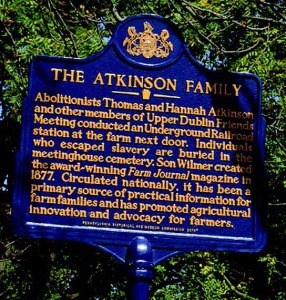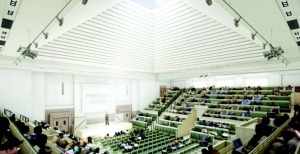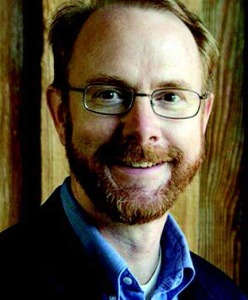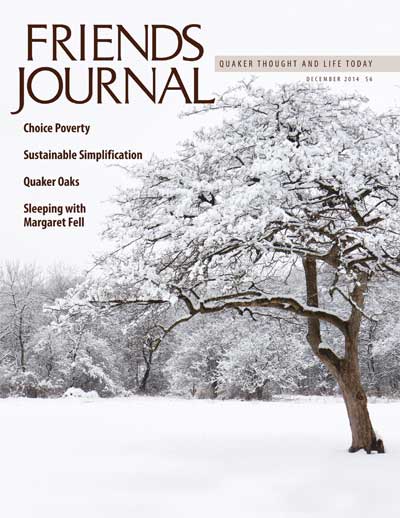Historical marker placed at a Pennsylvania Quaker meeting
 In a ceremony held on September 28, Upper Dublin (Pa.) Meeting celebrated the unveiling of a historical marker installed on the meeting grounds as administered by the Pennsylvania Historical and Museum Commission. The marker honors the Atkinson family, including Thomas and Hannah Atkinson, members of the meeting who offered safe haven on the Underground Railroad. The marker reads:
In a ceremony held on September 28, Upper Dublin (Pa.) Meeting celebrated the unveiling of a historical marker installed on the meeting grounds as administered by the Pennsylvania Historical and Museum Commission. The marker honors the Atkinson family, including Thomas and Hannah Atkinson, members of the meeting who offered safe haven on the Underground Railroad. The marker reads:
Abolitionists Thomas and Hannah Atkinson and other members of Upper Dublin Friends Meeting conducted an Underground Railroad station at the farm next door. Individuals who escaped slavery are buried in the meetinghouse cemetery. Son Wilmer created the award-winning Farm Journal magazine in 1877. Circulated nationally, it has been a primary source of practical information for farm families and has promoted agricultural innovation and advocacy for farmers.
The unveiling ceremony included statements from members of the meeting; a talk by novelist Samuel Lemon, author of Go Stand Upon the Rock, based on handed-down stories about his ancestors who were runaway slaves; a few words from Andy Weber, the current chief executive officer of Farm Journal; remarks from descendants of the Atkinsons; and a young Atkinson descendant singing “Imagine” by John Lennon.
New QuakerBooks website
QuakerBooks of FGC, the Quaker bookstore run by Friends General Conference (FGC), launched its new and improved website at Quakerbooks.org in October. Visitors to the site can easily browse titles by category (Quaker Books, Religion, History & Society, Spiritual Practice, Social Issues, Life Skills, Family & Community Life, Biography & Memoir, Arts & Literature, and Children & Young Adult) or by format (hardcover, paperback, eBook, and leaflet). There are a number of subcategories within the Quaker Books category, including resources for meetings, religious education, and Quaker history.
The QuakerBooks inventory receives new titles every week; visitors can click on the “New Arrivals” tab on the website to see the latest titles to arrive in the store. There is also a section of the site dedicated to used books, where the store sells secondhand Quaker books that have been donated by Friends and meetings who no longer need them. The “Our Picks” tab lists recommendations from FGC staff and committee members who pick their favorite books and explain why certain titles are important to them. Lastly, the “Bargain Books” tab features titles that are on sale, and the “Gifts & Merchandise” tab showcases a selection of items fit for gift-giving. Purchases can be made quickly and securely online, and all proceeds go to aid the work of FGC.
The site redesign was done by Message Agency, a web service company based in Philadelphia, Pa. QuakerBooks is the world’s largest Quaker bookshop, serving Quakers, Quaker meetings, and interested individuals. The shop carries books, pamphlets, eBooks, CDs, and other materials that help Friends and others live their lives as expressions of faith and learn about the Quaker way past and present.
Divisions in a Quaker yearly meeting
Growing divisions in North Carolina Yearly Meeting (Friends United Meeting) were discussed at a meeting of the representative body held on November 1 at Forsyth Meeting in Winston-Salem, N.C. Two months before at annual sessions, a committee was formed (called the New Committee) to address the concerns arising from various differences among NCYM (FUM) Friends. The committee was tasked with drafting and presenting a report to the representative body that included queries for Friends to consider in an attempt to find a way forward. At press, the group was still intent on discerning a way forward without a separation.
At the end of October, Max L. Carter, a member of NCYM (FUM), wrote an online post for Friends Journal to set the scene for the November 1 meeting, which many feared could have led to a separation within the yearly meeting. Carter explained the historical context of this occasion:
There have been tensions in NCYM (FUM) for many years over the usual theological and social issues, but unlike other North American yearly meetings, it did not experience a separation throughout the tumultuous nineteenth century of divisions into Hicksite, Orthodox, Gurneyite, Wilburite, Otisite, Kingite, Holiness, Conservative, and other branches. Only in 1904 did a small division occur, resulting in two yearly meetings: NCYM (Conservative) and our NCYM (FUM).
Prior to the meeting, more than a dozen meetings in NCYM (FUM) sent letters to the yearly meeting stating their concerns. Poplar Ridge Meeting in Trinity, N.C., one of the first meetings to call for drastic measures, cited four particular areas as sources of division: (1) differences over the person and work of Jesus Christ and the authority of scripture; (2) meetings that do not affirm the Faith and Practice of the yearly meeting, including the Richmond Declaration of Faith. Also mentioned is concern over meetings dually affiliated with the FUM yearly meeting and FGC through the new Piedmont Friends Yearly Meeting; (3) nonpayment of yearly meeting assessments (monetary dues to the yearly meeting); (4) leadership in the yearly meeting on the part of members of monthly meetings who are “out of harmony” with Faith and Practice. Some of the “offending” meetings have also sent letters stating their responses.
Carter reported back after the November 1 meeting:
I’m especially grateful for the hard work of the New Committee in bringing forward draft considerations and the wisdom of the group in discerning a way forward at this time without a separation. As one person so helpfully illustrated, separations are like the shoots on a Bradford Pear: they give immediate satisfaction, but they prove to be weak, and a good wind or light snow breaks them apart. I’m grateful, too, for the many voices who, typically quiet and unassuming, were catapulted out of their seats by Spirit in inspired messages to the body. As painful as it was at times, there were so many whose courage gives us hope.
Quakers in Britain unveil new venue
 On November 10, Friends House, the central offices of Quakers in Britain, officially unveiled one of London’s newest auditoriums called “The Light” at an exclusive launch event. According to the press release, the opening comes following a £4.5 million (over US$7 million) renovation partially prompted by an increasing demand for large events space in central London. The decision to refurbish the space came from the trustees of Britain Yearly Meeting, who desired to make Friends House a more versatile and sustainable building in addition to an attractive option for large conferences.
On November 10, Friends House, the central offices of Quakers in Britain, officially unveiled one of London’s newest auditoriums called “The Light” at an exclusive launch event. According to the press release, the opening comes following a £4.5 million (over US$7 million) renovation partially prompted by an increasing demand for large events space in central London. The decision to refurbish the space came from the trustees of Britain Yearly Meeting, who desired to make Friends House a more versatile and sustainable building in addition to an attractive option for large conferences.
The Light is the main hall in the Friends House building, located opposite Euston railway station, and has traditionally been used as the venue for Britain Yearly Meeting gatherings. The new 1,000-seat-capacity auditorium is described as “simple and fitting for worship” and “a haven in the city and expressive of radical ideas.” The space can be transformed into a smaller, more intimate setting to host groups of up to 570 people.
Key heritage features of the 88-year-old building have been retained, such as the wooden paneling and large windows, while new additions have been installed to make the space more contemporary, including a stunning roof light and vaulted roof. The roof light allows light in from above, not seen since the original clerestory windows of the award-winning 1926 Hubert Lidbetter design were hidden by the 1950s ceiling.
Paul Grey, head of hospitality at Friends House commented, “We view The Light as a unique asset to the Quaker community, as well as the local community and beyond. The Light is not only a fantastic contemporary events space; it is also an important place of history at the heart of the Quakers’ centrally managed operations in Britain. As such, respect for heritage and the environment are of paramount importance to us.” Grey further commented, “Ideally, we want The Light to become the venue of choice for the third sector in this country.”
The architecture firm used for the project is John McAslan + Partners. The building company is Westco Partnership, who, in addition to working on The Light, is redeveloping the Friends House garden and installing an electricity sub-station, an external lift, and gently sloping paths to improve access for all.
Learn more about The Light at thelightateuston.org.uk, about Friends House at friendshouse.co.uk, and about Quakers in Britain at quaker.org.uk.
Appointment
 Friends Center Corporation, operator of Friends Center facility and campus for Quaker activity in center city Philadelphia, Pa., announced the appointment of Christopher Mohr as its new executive director effective January 1, 2015. Mohr brings 20 years nonprofit experience in management, supervision, finances and budgeting, a strong capacity to work collaboratively, and familiarity with real estate management. He will work with Friends Center’s current executive director, Patricia McBee, during the month of December before taking over the position in the new year.
Friends Center Corporation, operator of Friends Center facility and campus for Quaker activity in center city Philadelphia, Pa., announced the appointment of Christopher Mohr as its new executive director effective January 1, 2015. Mohr brings 20 years nonprofit experience in management, supervision, finances and budgeting, a strong capacity to work collaboratively, and familiarity with real estate management. He will work with Friends Center’s current executive director, Patricia McBee, during the month of December before taking over the position in the new year.
Since moving to Philadelphia from San Francisco, Calif., in 2011, Mohr has served as resource development manager for the Community Design Collaborative, where he manages diverse revenue streams from individuals, corporations, and foundations. Through this position, he has connected with many of the community development corporations, civic associations, and public agencies in Philadelphia.
While living in San Francisco, Mohr was the executive director of the Housing Leadership Council of San Mateo County, Calif., for nearly eight years. He managed HEART of San Mateo County (Housing Endowment and Regional Trust), an affordable housing trust fund for the county and all 20 of its cities. In addition to general management and financial reporting duties, he was responsible for cultivating and maintaining relationships with the various board members and the 21 jurisdictions.
Since 2011 Mohr has served as the clerk of the board of trustees of Friends Publishing Corporation, publisher of Friends Journal magazine and lead partner of the QuakerSpeak video series. He lives with his wife and two children in the Germantown neighborhood of Philadelphia and is a member of nearby Green Street Meeting.



Comments on Friendsjournal.org may be used in the Forum of the print magazine and may be edited for length and clarity.